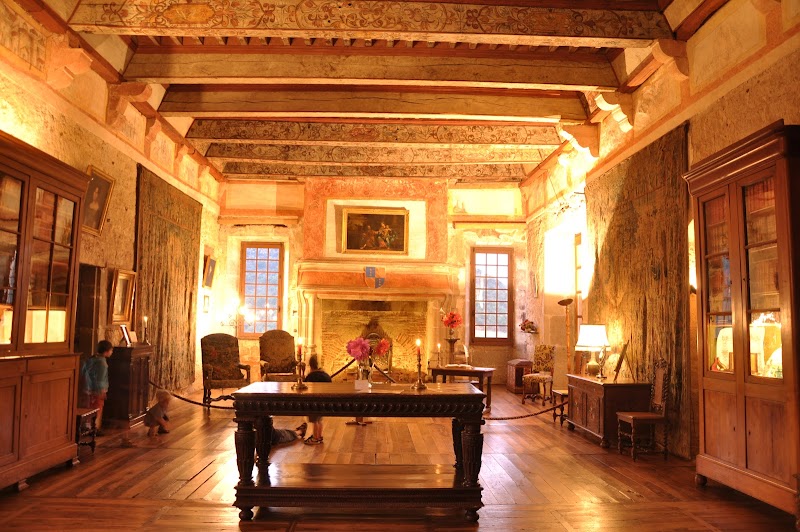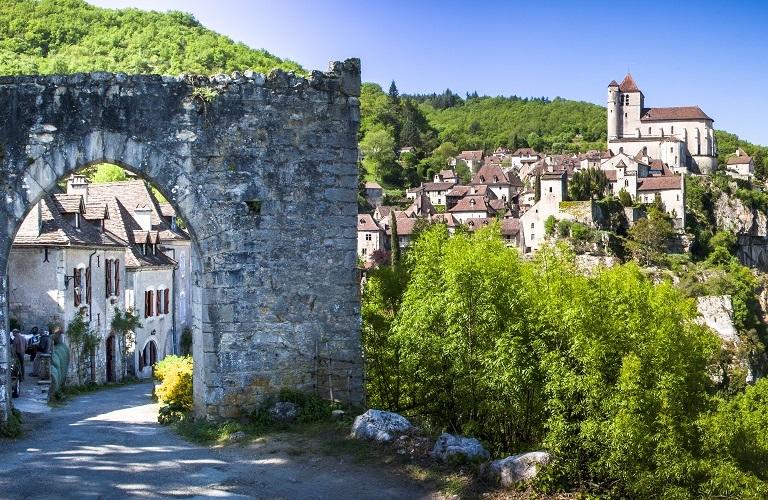Welcome to Saint-Cirq-Lapopie
Have you ever heard of Saint-Cirq-Lapopie? This quaint medieval village nestled in the heart of France has captivated both locals and tourists with its enchanting cobblestone streets, picturesque half-timbered houses, and breath-taking views over the Lot River. It even holds the title of being voted as 'the most beautiful village in the country' by the French.
Before you embark on your journey, take a moment to familiarize yourself with our comprehensive tourist map of Saint-Cirq-Lapopie. This invaluable tool will guide you through the winding lanes of this charming village, helping you uncover hidden gems and navigate your way around effortlessly. Get ready for an unforgettable journey through time, as every corner of Saint-Cirq-Lapopie holds a piece of history waiting to be discovered.
Booking.comExploring the Wonders of Saint-Cirq-Lapopie
While the entire village of Saint-Cirq-Lapopie is a treasure trove, certain key attractions stand out for their historical significance and unique experiences. Discover the rich history of the village as you visit these must-see attractions. If you are interested in exploring more picturesque villages in France, check out our tourist map of southern villages of France.
Must-See Attractions
- The Church of Saint-Cirq-Lapopie
- The Lapopie Castle
- The Rignault Museum
- The Grotte du Pech-Merle
- Le Chemin de Halage
The Church of Saint-Cirq-Lapopie: A Journey into the Past
Step into the Church of Saint-Cirq-Lapopie, and you're stepping into an era gone by. This 13th-century Romanesque church houses a piece of the village's Christian heritage. The interior of the church, with its simple yet poignant beauty, creates a serene atmosphere that invites introspection and reverence. Don't miss the opportunity to climb the church's bell tower, where a breathtaking panorama of the village awaits you.
Lapopie Castle: A Testament to Medieval Grandeur
Perched atop the highest point of the village, the Lapopie Castle guarantees stunning views of the surrounding Lot Valley. This medieval fortress with its imposing stone walls and towers used to be the residence of the Lords of Lapopie. Today, the castle ruins serve as a silent testament to the village's past. As you explore the castle's grounds, you can almost hear the echoes of the vibrant medieval life that once thrived here.
The Rignault Museum: A Cultural Treasure of Saint-Cirq-Lapopie
Located in a 17th-century mansion, the Rignault Museum is a cultural gem of Saint-Cirq-Lapopie. The museum houses a collection of artworks by various local artists, thus providing a glimpse into the village's thriving arts scene. Wander through the museum's exhibits, and you'll discover the artistic soul that continues to enliven Saint-Cirq-Lapopie. After your visit, take a quiet stroll through the museum's beautiful garden.
The Grotte du Pech-Merle: A Gateway into Prehistoric Times
Just a short drive from Saint-Cirq-Lapopie, you'll find the Grotte du Pech-Merle, one of the few prehistoric cave systems open to the public. This natural wonder takes you deep into the earth, where you'll find astonishing cave paintings dating back 25,000 years. The experience is both humbling and awe-inspiring, reminding you of the enduring power of human creativity. It's a must-visit destination for anyone interested in prehistoric art and history.
Le Chemin de Halage: A Scenic Riverside Walk
Finally, no visit to Saint-Cirq-Lapopie would be complete without a stroll along Le Chemin de Halage. This old towpath, carved into the cliffside by the Lot river, offers a tranquil walk with stunning views of the river and the surrounding countryside. It's the perfect place to unwind and soak in the natural beauty of the Lot Valley.
Conclusion
Whether it's the historical allure, the artistic charm, or the natural beauty, there's something in Saint-Cirq-Lapopie for everyone. Every corner of this medieval village offers a unique experience that you won't find anywhere else. So pack your bags, and get ready to step into a world where the past and the present meet in perfect harmony.

Practical Information for Visiting Saint-Cirq-Lapopie
Transportation and Mobility
Accessible by both car and public transportation, Saint-Cirq-Lapopie offers various options for visitors to explore the village. The nearest railway station is in Cahors, about 30 kilometers away. From there, you can take a taxi or a local bus line (Line 910) to reach the village. If you're traveling by car from Toulouse or Bordeaux, take the A20 motorway and exit at Cahors. For those who prefer the charm of a river journey, river cruises operate on the Lot River, providing a different perspective of the village's beauty.
Schedules and Prices
While the village itself can be visited at any time, the opening hours of the local shops and restaurants generally range from 10 am to 7 pm. The Rignault Museum typically operates from 10 am to 6 pm from April to November, with an admission fee of €2.50 for adults and free entry for children under 12. For guided tours, prices can range from €5 to €10, depending on the duration and specific tour.
Safety Tips
Despite being a popular tourist destination, Saint-Cirq-Lapopie maintains a safe and secure environment. However, it's always wise to take basic precautions. Keep an eye on personal belongings in crowded areas, especially during the peak tourist season. The village's cobblestone streets can be slippery when wet, so wear comfortable, non-slip shoes. Also, remember that the village is perched on a cliff, so children should be supervised near the edge.
Practical Recommendations
The best times to visit Saint-Cirq-Lapopie are during the spring and fall seasons. During these periods, the village is less crowded, and the weather is particularly pleasant for outdoor activities. The summer season, while beautiful, sees a surge in tourist numbers. It's recommended to arrive early in the day, especially during peak season, to find parking and avoid the biggest crowds. Also, consider staying overnight in one of the village's charming guesthouses to experience the magic of Saint-Cirq-Lapopie after the day-trippers have left.

Frequently Asked Questions
1. What is the best time of the year to visit Saint-Cirq-Lapopie?
While Saint-Cirq-Lapopie is a year-round destination, the best time to visit is between May and September when the weather is most favorable. However, keep in mind that these months also coincide with the peak tourist season, so you may want to book accommodations in advance.
2. Are there any unique events or festivals in Saint-Cirq-Lapopie?
Yes, indeed! The village is alive with cultural events throughout the year. One of the highlights is the annual 'Fête des Plantes et du Massif', a garden festival held in April. Also, the 'Festival de Saint-Cirq-Lapopie' in July features a variety of music, theatre, and dance performances.
3. Can I find vegetarian or vegan food in Saint-Cirq-Lapopie?
While the local cuisine in Saint-Cirq-Lapopie is heavily meat-based, you'll still find options that cater to vegetarian or vegan diets. Some restaurants offer vegetarian versions of regional dishes, and there are also organic stores where you can find vegan products.
4. Are there any opportunities for outdoor activities?
Absolutely! The surrounding Lot Valley offers a plethora of outdoor activities including hiking, cycling, horseback riding, and canoeing. The 'GR 36' long-distance footpath, which passes through Saint-Cirq-Lapopie, is a popular choice among hikers.
5. Is Saint-Cirq-Lapopie suitable for families with children?
Yes, it is. Saint-Cirq-Lapopie is a family-friendly destination. There are plenty of activities for children such as exploring the medieval village, visiting the castle ruins, and taking boat trips on the Lot River. Plus, the 'Grotte du Pech-Merle' cave with its prehistoric paintings is a big hit with kids.
6. Is there any local product or souvenir that is unique to Saint-Cirq-Lapopie?
When in Saint-Cirq-Lapopie, don't miss the chance to buy local artisanal products. The village is known for its handicrafts, especially ceramics and woodwork. Also, locally produced saffron and its derived products are popular souvenirs.

